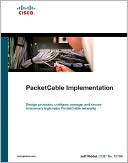Next Generation IPTV Services and Technologies
With a focus on changing job tasks and knowledge requirements for professionals, this book enables readers to meet the demands of designing, implementing, and supporting end-to-end IPTV systems. Additionally, it examines IPTV technical subjects that are not included in any other single reference to date: Quality of Experience (QoE), techniques for speeding up IPTV channel changing times, IPTV CD software architecture, Whole Home Media Networking (WHMN), IP-based high-definition TV,...
Search in google:
Detailed coverage of the underlying technologies required to build an end-to-end IPTV systemThe television entertainment industry is currently experiencing a major transformation as broadband subscribers and improvements in compression techniques for digital video content continue to grow. This growth is fueling the demand for a new generation of technology professionals who will be responsible for implementing IP-based video services and digital home services around the world. Next Generation IPTV Services and Technologies explores key challenges associated with successfully managing the technical operation of an IPTV networking infrastructure and provides networking and IT specialists entering the IPTV sector with sound coverage of state-of-the-art technologies used to build end-to-end IPTV systems. Coverage includes:IPTV network distribution technologiesIPTV real-time encoding and transportationBroadcasting linear programming over IPTVIPTV consumer devices IPTV conditional access and DRM systemsMoving IPTV around the houseVideo-on-demand over IP delivery networksAdditionally, this book examines IPTV technical subjects that are not included in any other single reference to date: Quality of Experience (QoE), techniques for speeding up IPTV channel changing times, IPTV CD software architecture, Whole Home Media Networking (WHMN), IP-based high-definition TV, interactive IPTV applications, and managing an IPTV network on a daily basis. With a focus on changing job tasks and knowledge requirements for professionals, Next Generation IPTV Services and Technologies enables telecom operators, wireless mobile providers, cable TV companies, media companies, broadcasters, video production companies, and Internet portal companies to meet the demands of designing, implementing, and supporting end-to-end IPTV systems. Complete with helpful flowcharts and engineering schematics, it also serves as an ideal supplemental text for graduate- and postgraduate-level networking and IP protocol courses.
Dedications. Preface. Organizational and Topical Coverage. Who should read this book. Acknowledgements. About the Author. Foreword. Chapter 1. The Ultimate Viewing Experience. 1.1 Defining IPTV. 1.2 Differences between IPTV and Internet TV. 1.3 Overview of an IPTV Networking Infrastructure. 1.4 Key IPTV Applications and Services. 1.5 Growth Drivers for IPTV. 1.6 Market Data. 1.7 Industry Initiatives to Standardize IPTV. 1.8 Summary. Chapter 2. IPTV Network Distribution Technologies. 2.1 'Last Mile' Broadband Distribution Network Types. 2.2 IPTV over a Fiber Access Network. 2.3 IPTV over an ADSL Network. 2.4 Next Generation Cable TV Networks. 2.5 IPTV over a Satellite Based Network. 2.6 IPTV over Wireless Networks. 2.7 IPTV over the Interne t. 2.8 IPTV Backbone Technologies. 2.9 Network Factors Associated with Deploying IPTV. 2.10 Summary. Chapter 3. IPTV Real Time Encoding and Transportation. 3.1 Introduction to Real-Time Encoding. 3.2 Compression Methods. 3.3 Packetizing and Encapsulating Video Content. 3.4 Summary. Chapter 4. Broadcasting Linear Programming over IPTV. 4.1 Underlying Video Components of an end-to-end IPTV System. 4.2 Different Approaches to Streaming IPTV Content. 4.3 Multicasting across an IPTV Network. 4.4 IPTV Multicasting Networking Architecture. 4.5 Multicasting IPTV Content across IPV6 Networks. 4.6 Introduction to Channel Changing. 4.7 Fundamentals of Channel Changing. 4.8 Techniques for Speeding up IPTV Channel Changing Times. 4.9 Discovering Channel Program Information. 4.10 Time Shifting Multicast IPTV. 4.11 Channel Changing Industry Initiatives. 4.12 Summary. Chapter 5. IPTV Consumer Devices (IPTVCDs). 5.1 About Residential Gateways. 5.2 RG Technology Architecture. 5.3 RG Functionality. 5.4 RG Industry Standards. 5.5 Introduction to Digital Set-top Boxes. 5.6 The Evolution of Digital Set-top Boxes. 5.7 Categories of Digital Set-top Boxes. 5.8 Major Technological Trends for Digital Set-Top Boxes. 5.9 IP Set-top Boxes Defined. 5.10 Types of IP Set-top Boxes. 5.11 Other Emerging IPTV Consumer Devices. 5.12 Summary. Chapter 6. IPTVCD Software Architecture. 6.1 What Makes an IPTVCD Tick? 6.2 Interactive TV Middleware Standards. 6.3 Proprietary Middleware Solutions. 6.4 Summary. Chapter 7. IPTV Conditional Access and DRM Systems. 7.1 Introduction to IPTV Security. 7.2 Defining IPTV CA Security Systems. 7.3 CA Industry Initiatives. 7.4 Introduction to Next Generation DRM Solutions. 7.5 IPTV Intranet Protection. 7.6 Summary. Chapter 8. Moving IPTV around the House. 8.1 About Whole Home Media Networking (WHMN). 8.2 WHMN Enabling Technologies. 8.3 Fast Ethernet & Gigabit Ethernet (GigE). 8.4 802.11n. 8.5 HomePlug AV. 8.6 UPA-DHS. 8.7 HomePNA™ 3.1. 8.8 WHMN Middleware Software Standards. 8.9 QoS and WHMN Applications. 8.10 Summary. Chapter 9. Video-on-Demand (VoD) over IP Delivery Networks. 9.1 History of Pay-Per-View. 9.2 Understanding PPV. 9.3 The Emergence of RF and IP Based VoD. 9.4 Types of IP-VoD Services. 9.5 Underlying Building Blocks of an end-to-end IP-VoD Infrastructure. 9.6 Video Server Architectures. 9.7 Integrating IP-VoD Applications with other IP based Services. 9.8 Protecting IP-VoD Content. 9.9 Summary. Chapter 10. IP Based High Definition TV. 10.1 Overview of SDTV and HDTV Technologies. 10.2 HDTV over IP Defined. 10.3 An end-to-end IP HDTV System. 10.4 Summary. Chapter 11. Interactive IPTV applications. 11.1 The Evolution of iTV. 11.2 About iTV. 11.3 Interactive IPTV Applications. 11.4 IPTV Program Related Interaction Applications. 11.5 Deploying Interactive IPTV Applications. 11.6 Accessibility to IPTV Services. 11.7 Summary. Chapter 12. IPTV Network Administration. 12.1 An Introduction to IPTV Network Administration. 12.2 Supporting the IPTV Networking Management System (NMS). 12.3 Managing Installation, Service Problems, and Terminations. 12.4 Network Testing and Monitoring. 12.5 Ensuring Service Availability and Managing Redundancy. 12.6 IP Address Space Management. 12.7 Routine IT and Network Administrative Tasks. 12.8 Managing IPTV Quality of Service (QoS) Requirements. 12.9 Monitoring the IPTV Subscriber Experience. 12.10 Remotely Managing in-Home Digital Consumer Devices. 12.11 Scheduling and Managing Delivery of Software Updates to IPTVCDs. 12.12 Troubleshooting IPTV Problems. 12.13 IPTV and Business Continuity Planning. 12.14 Summary. Index.







